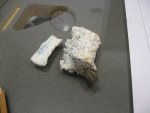You are using an out of date browser. It may not display this or other websites correctly.
You should upgrade or use an alternative browser.
You should upgrade or use an alternative browser.
Aluminum splice on copper conductors
- Thread starter bbaumer
- Start date
- Status
- Not open for further replies.
tell me that was a neutral connection, and not a hot connection in a MV manhole. Those H taps are usually 1350 alloy. Pretty much another way of saying almost pure AL. Like you, I don't understand why a copper H or C tap wasn't used.
Last edited:
tell me that was a neutral connection, and not a hot connection in a MV manhole. Those H taps are usually 1350 alloy. Pretty much another way of saying almost pure AL. Like you, I don't understand why a copper H or C tap wasn't used.
Yep. The neutrals on this system are either separate 600V conductors or are concentric wrapped around the MV cable (part of the cable). The MV cable is typically individual XLP or EPR, 133%, 220mil, 15 kv conductors although there is still some old PILC (paper insulated lead covered) cable we haven't changed yet as well as armored cable here and there. Most of the terminations are 200A or 600A, load break or dead break elbows on SF6 gas switches but we do have some air switches.
University setting, large distribution system. Literally miles of 15kv cable in ductbanks.
Last edited:
Yep. The neutrals on this system are either separate 600V conductors or are concentric wrapped around the MV cable (part of the cable). The MV cable is typically individual XLP or EPR, 133%, 220mil, 15 kv conductors although there is still some old PILC (paper insulated lead covered) cable we haven't changed yet as well as armored cable here and there. Most of the terminations are 200A or 600A, load break or dead break elbows on SF6 gas switches but we do have some air switches.
University setting, large distribution system. Literally miles of 15kv cable in ductbanks.
Just a quick question, You glad to get the job protection? How long would it take to brush and resqueeze every neutral connection? I have only seen PILC cable, never had the privilege(?) to work on it.(thankfully)
Seems the SF6 switches will leak down too far just when you need them. We had one that was little more than a junction point. wouldn't hold gas more than a week.
Just a quick question, You glad to get the job protection? How long would it take to brush and resqueeze every neutral connection? I have only seen PILC cable, never had the privilege(?) to work on it.(thankfully)
Seems the SF6 switches will leak down too far just when you need them. We had one that was little more than a junction point. wouldn't hold gas more than a week.
I don't understand your first question.
As far as the SF6 switches go they have been very good. Started using them maybe 15 years ago or so. They were Joslyn switches at that time and were bought by Canada Power. They are PufferPak switches. http://www.canadapowerproducts.com/downloads/catalogs/sf6.pdf Most of the switches are in manholes and several have been submerged under water although we try to check all the holes periodically to make sure the sump pumps are working, sometime you have failures. Yes, we have had a couple switches develop leaks but since we have a pretty good PM program we caught them before they were a problem. I don't know how many of these switches we have for sure but I'd guess well over 50 easy. We have a handful of padmounted switches as well. Basically the same switch just on a pad inside a green sheetmetal box.

Last edited:
I don't understand your first question.
As far as the SF6 switches go they have been very good. Started using them maybe 15 years ago or so. They were Joslyn switches at that time and were bought by Canada Power. They are PufferPak switches. http://www.canadapowerproducts.com/downloads/catalogs/sf6.pdf Most of the switches are in manholes and several have been submerged under water although we try to check all the holes periodically to make sure the sump pumps are working, sometime you have failures. Yes, we have had a couple switches develop leaks but since we have a pretty good PM program we caught them before they were a problem. I don't know how many of these switches we have for sure but I'd guess well over 50 easy. We have a handful of padmounted switches as well. Basically the same switch just on a pad inside a green sheetmetal box.

I was just commenting on the time it would take to clean all the connections and resqueeze them. Some people would love to have the extra work in today's economy.
We have had three of the switches develop leaks, they are over 20 years old though. We don't have near the numbers you have though.
- Status
- Not open for further replies.


